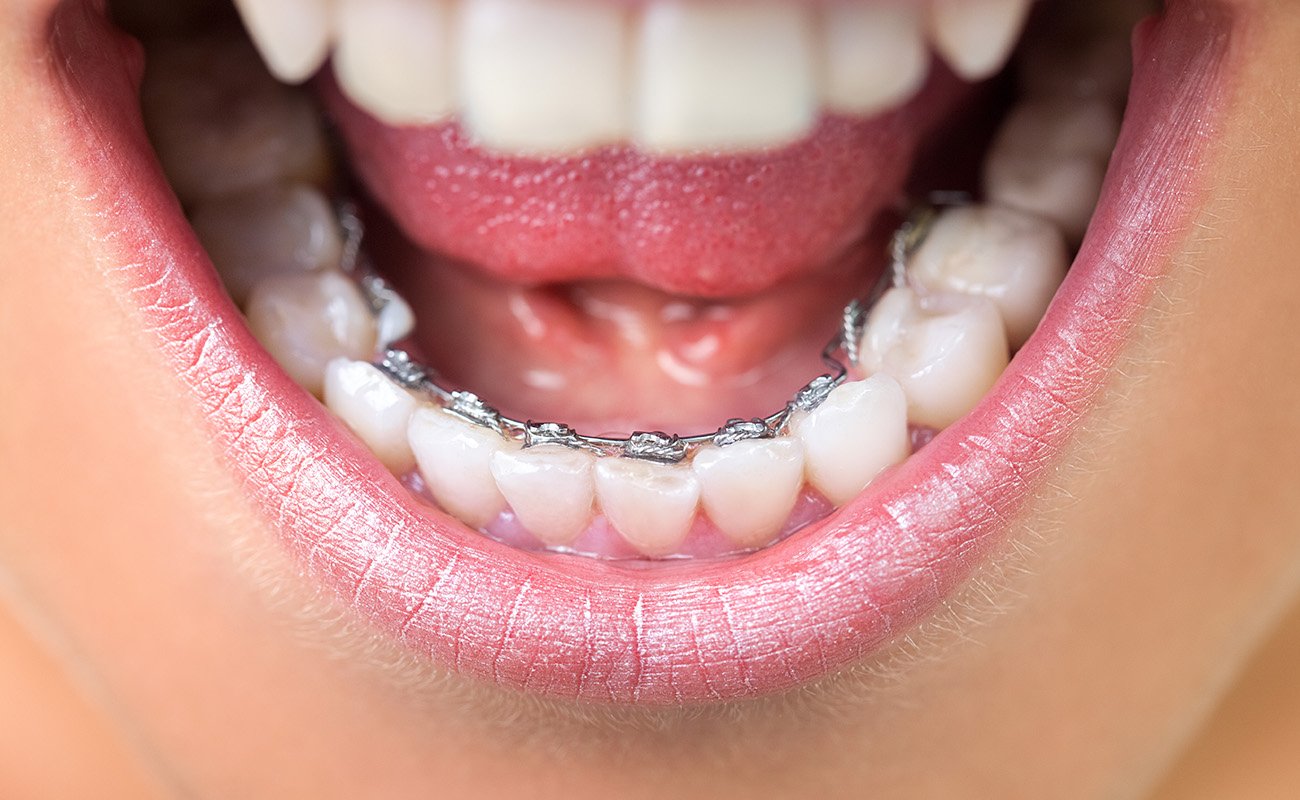Braces have come a long way from the days of clunky metal mouth gear. Today, adults and teens alike can transform their smiles with more discreet orthodontic treatments. Invisalign, known for its clear, removable aligners, offers a nearly invisible solution to teeth straightening. Meanwhile, Incognito Braces, which are attached to the back of the teeth, provide an alternative for those looking for an effective, yet hidden, orthodontic solution.
This article aims to provide a balanced comparison between Incognito Braces and Invisalign, highlighting their unique features, benefits, and how they might suit different dental needs. Whether you are considering braces or aligners, this Incognito braces vs Invisalign comparison should help you make an informed decision.
Incognito Braces
Lingual braces are distinguished by their placement on the back surfaces of the teeth, making them invisible from the front. Custom-made for each patient, the brackets and wires are precisely fitted to the lingual (tongue side) surface of the teeth. This customization ensures a close fit and effective application of pressure needed to move the teeth into their desired positions.
One of the most significant advantages of lingual braces is their aesthetic appeal, as they remain hidden from view. However, their placement can lead to initial discomfort and irritation to the tongue, and some people may experience a temporary impact on speech clarity.
The location of lingual braces also presents a challenge in terms of oral hygiene, as cleaning around the brackets and wires is more difficult compared to traditional braces. This increases the risk of plaque buildup and necessitates a more diligent oral care routine to prevent potential staining of the teeth.
Invisalign
Invisalign aligners are crafted from transparent plastic using advanced 3D imaging technology, which precisely maps the patient’s dental structure to create a series of custom-fitted trays. Each set of trays is designed to be worn for approximately two weeks, applying gentle pressure to the teeth to move them incrementally toward their final, corrected positions.
One of the primary benefits of clear aligners is their subtlety; their transparent material makes them virtually invisible. Additionally, their removable nature allows for easier eating, brushing, and flossing, contributing to better overall oral hygiene during treatment.
However, the effectiveness of clear aligners depends significantly on the patient’s diligence in wearing them for the recommended 20-22 hours a day. While they can address a variety of dental issues such as overcrowding, gaps, and some bite irregularities, they might not be suitable for more severe orthodontic needs. There’s also a risk of staining the aligners if they’re not maintained properly, though this is mitigated by the fact that each set is only worn for a short period before being replaced by the next in the series.

Worth Knowing
According to the article published in The Angle Orthodontist, aligner therapy requires significantly fewer visits to an orthodontist and a shorter treatment time than braces.
Differences Between Incognito Braces and Invisalign
Discreet and comfortable orthodontic treatments, such as incognito braces (also referred to as lingual braces) and Invisalign, offer patients the ability to discreetly correct misaligned teeth without advertising that they are undergoing treatment. However, there are substantial differences between these two options:
- Removability: Invisalign aligners are fully removable by the patient, allowing for easier eating and oral hygiene practices. Lingual braces, like traditional braces, are fixed to the teeth with brackets and can only be removed by an orthodontist.
- Ease of Cleaning: Lingual braces can trap food particles and are more challenging to clean, increasing the risk of plaque buildup. In contrast, Invisalign aligners can be taken out, allowing for thorough cleaning of both the aligners and the teeth.
- Comfort: The brackets of lingual braces may cause more discomfort due to irritation of the tongue and soft tissues inside the mouth. Invisalign aligners, made from smooth plastic, tend to be more comfortable and less likely to irritate the mouth’s interior.
- Compliance: Invisalign treatment requires the patient to wear the aligners for at least 22 hours a day, relying on the patient’s diligence to put them back in after each removal, which could affect treatment effectiveness if not followed.
- Treatment Suitability: Clear aligners like Invisalign are generally more suited for mild to moderate teeth straightening cases. In contrast, lingual braces can address a broader range of orthodontic issues, from mild to severe.
Worth Knowing
The study published on PubMed Central reveals that a significant number of adults favor discreet orthodontic solutions like aligners or lingual braces.
Cost of Incognito Braces vs Invisalign
When it comes to cost, there is a significant price difference between these two discreet teeth straightening treatments. Invisalign clear aligner therapy typically costs between $3,000 to $8,000 in total. The final price is influenced by the complexity of one’s case and how many aligners are required throughout treatment. Incognito lingual braces, on the other hand, tend to cost between $8,000 to $10,000 overall. This pricing discrepancy stems from the fully customized brackets and wires that have to be fabricated for the backs of each patient’s teeth with Incognito. While aesthetics are unbeatable with Incognito, the more intensive process involved means it comes at a greater financial premium.
See our article: Types of Clear Braces.
Alternatives to Invisalign
If you’re looking for an affordable alternative to Invisalign, there are several brands of clear aligners available on the market.
Unlike Invisalign, these products offer at-home delivery with no need to visit an orthodontist. The convenience and cost savings of using at-home delivery make them a great choice for those who want a quick, hassle-free treatment without breaking the bank.
Some of the most popular brands include Byte, and Candid, all offering similar types of treatments with great results, though their prices may vary from one another slightly. These companies sell custom-made, high-quality aligners of similar quality to the Invisalign product that requires only self-monitoring or advice from customer care professionals over the phone, all for much cheaper than Invisalign.
Here are some reviews of the best available clear aligners:
AlignerCo is a well-known brand that provides an affordable aligner program. Their prices are lower than most other aligner brands, with treatment starting at just $945, which also includes free retainers and a teeth whitening kit.

AlignerCo
The cheapest at-home aligners, with monthly plans, no down payment, and considerable discounts.
Check out AlignerCo AlignersNewSmile is one of the newest aligner brands on the market and is known for its affordability. When you purchase their aligners, you receive an impression kit, whitening foam, aligners, and retainers. This brand also provides monthly payment plans without requiring any initial payments, offers a video call option with a specialist to assist with mouth impressions, and has a user-friendly online assessment process.

NewSmile
Affordable at-home treatment with positive reviews offering superior look and comfort.
Check out NewSmile AlignersByte is a well-known brand that offers a lifetime guarantee for your aligners. This means that if your teeth don’t stay in the desired treatment position afterward, you’ll receive additional impression kits, treatment plans, and sets of aligners at no additional cost to correct any misalignments.

Byte
An affordable option with refundable impression kits, free HyperByte, and a Byte for Life guarantee.
Check out Byte AlignersCandid is a highly regarded aligner product with a treatment approach similar to Invisalign. Unlike the other brands mentioned, Candid doesn’t offer a direct-to-home ordering service. Instead, a qualified orthodontist will assess your eligibility for treatment. The advantage is that you won’t need regular appointments after starting treatment. Candid aligners are suitable for addressing both mild and severe spacing issues.

Candid
A hybrid of in-office and at-home treatment that provides 1-on-1 orthodontist support.
Check out Candid AlignersIncognito Braces vs Invisalign – What Option is the Best For You?
When considering Incognito lingual braces versus Invisalign aligner therapy, there are good reasons why both modern orthodontic options have become so popular. Incognito offers unparalleled esthetics and discretion with completely hidden braces customized to fit behind your teeth. Meanwhile, Invisalign provides an affordable and convenient clear aligner treatment that fits right into your lifestyle.
Ultimately, choosing between the two methods depends largely on your personal priorities, unique orthodontic case, and budget. Patients wanting the absolute utmost in invisibility while having complex issues to resolve may find Incognito worth the significant investment. On the other hand, Invisalign works wonderfully for less severe issues without the high price of lingual braces.
Ultimately, the best route is the one tailored to what you hope to achieve and your current dental and financial situation.
Frequently Asked Questions
Are Lingual Braces Better Than Invisalign?
Invisalign offers a better solution for mild teeth straightening issues mainly due to the added convenience wearing them offers, but for more severe problems lingual braces are better as they give more strength in moving the teeth.
Are Lingual Braces Cheaper than Invisalign?
Not in most cases as lingual braces cost between $8,000 to $10,000 per treatment versus $3,500 to $8,000 for Invisalign. The overall cost of each varies depending on the length of treatment time needed and the severity of the issue.
Does Lingual Braces Take Longer than Invisalign?
Yes, lingual braces generally take around 18 to 24 months of treatment, whereas Invisalign on average takes around 12 months. However, the time that is needed to treat a patient’s teeth depends on the complexity of the treatment plan needed.
Are Incognito Braces More Uncomfortable than Invisalign?
Yes, due to Incognito braces using metal and wires, they can irritate the inside of the mouth at the start of treatment. Invisalign uses plastic trays and as such is much more comfortable to wear.
Sources
Galan-Lopez, L., Barcia-Gonzalez, J., Plasencia, E., A systematic review of the accuracy and efficiency of dental movements with Invisalign®; Korean J Orthod. 2019 May; 49(3): 140–149; 2019. DOI: 10.4041/kjod.2019.49.3.140. Available online at: https://www.ncbi.nlm.nih.gov/pmc/articles/PMC6533182/
Papageorgiou, S. N., Gölz, L., Jäger, A., Eliades, T., Bourauel, C., Lingual vs. labial fixed orthodontic appliances: systematic review and meta-analysis of treatment effects. Eur J Oral Sci. 2016;124(2):105-18. DOI: 10.1111/eos.12250. Available online at: https://pubmed.ncbi.nlm.nih.gov/26916846/
Jaber, S. T., Hajeer, M. Y., Sultan, K., Treatment Effectiveness of Clear Aligners in Correcting Complicated and Severe Malocclusion Cases Compared to Fixed Orthodontic Appliances: A Systematic Review, Cureus. 2023 Apr; 15(4): e38311. DOI: 10.7759/cureus.38311. Available online at: https://www.ncbi.nlm.nih.gov/pmc/articles/PMC10148732/
Alajmi S., Shaban A, Al-Azemi R. Comparison of short-term oral impacts experienced by patients treated with Invisalign or conventional fixed orthodontic appliances. Medical Principles and Practice. 2019. Available online at: https://pubmed.ncbi.nlm.nih.gov/31842018/
Alansari, R. A., Faydhi, D. A., Ashour, B. S., Alsaggaf, D. H., Shuman, M. T., Ghoneim, S. H., Linjawi, A. I., Marghalani, H. YA., Dause, R. R>, Adult Perceptions of Different Orthodontic Appliances, Patient Prefer Adherence. 2019; DOI: 10.2147/PPA.S234449. Available online at: https://www.ncbi.nlm.nih.gov/pmc/articles/PMC6916694/
Buschang, P.H., Shaw S.G., Ross M., Crosby D., Campbell P.M., Comparative time efficiency of aligner therapy and conventional edgewise braces. Angle Orthod (2014). DOI: 10.2319/062113-466. Available online at: https://meridian.allenpress.com/angle-orthodontist/article/84/3/391/58505/

